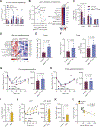BCAA-nitrogen flux in brown fat controls metabolic health independent of thermogenesis
- PMID: 38653240
- PMCID: PMC11145561
- DOI: 10.1016/j.cell.2024.03.030
BCAA-nitrogen flux in brown fat controls metabolic health independent of thermogenesis
Abstract
Brown adipose tissue (BAT) is best known for thermogenesis. Rodent studies demonstrated that enhanced BAT thermogenesis is tightly associated with increased energy expenditure, reduced body weight, and improved glucose homeostasis. However, human BAT is protective against type 2 diabetes, independent of body weight. The mechanism underlying this dissociation remains unclear. Here, we report that impaired mitochondrial catabolism of branched-chain amino acids (BCAAs) in BAT, by deleting mitochondrial BCAA carriers (MBCs), caused systemic insulin resistance without affecting energy expenditure and body weight. Brown adipocytes catabolized BCAA in the mitochondria as nitrogen donors for the biosynthesis of non-essential amino acids and glutathione. Impaired mitochondrial BCAA-nitrogen flux in BAT resulted in increased oxidative stress, decreased hepatic insulin signaling, and decreased circulating BCAA-derived metabolites. A high-fat diet attenuated BCAA-nitrogen flux and metabolite synthesis in BAT, whereas cold-activated BAT enhanced the synthesis. This work uncovers a metabolite-mediated pathway through which BAT controls metabolic health beyond thermogenesis.
Keywords: amino acid metabolism; bioenergetics; brown adipose tissue; diabetes; glucose homeostasis; insulin resistance; inter-organ communication; mitochondria; thermogenesis.
Copyright © 2024 The Author(s). Published by Elsevier Inc. All rights reserved.
Conflict of interest statement
Declaration of interests The authors declare no competing interests.
Figures






References
Publication types
MeSH terms
Substances
Grants and funding
LinkOut - more resources
Full Text Sources
Molecular Biology Databases
Research Materials

